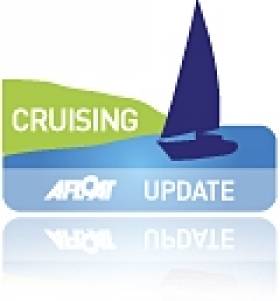Displaying items by tag: dinghy cruising
Irish Branch of Dinghy Cruising Association Looks to Put the Focus Back on No-Pressure Sailing
Afloat was ahead of its time in predicting the popularity of dinghy cruising in Ireland, says Stephen Foyle, who represents part of a new effort to share the cruising experience here.
Citing a 2012 article — Is ‘Adventure Sailing’ a New Tack for Dinghy Sailors? — Foyle, who is secretary of the Irish section of the Dinghy Cruising Association established last year, notes that membership of the UK-based body has nearly tripled in the last decade, from 468 members in 2012 to 1,208 today, averaging 70-80 members each quarter, and that membership is now worldwide. He continues:
Our numbers here are small but it is obvious there is a strong appetite for this type of sailing. We tentatively organised two sailing get togethers on Loughs Derg and Erne for 2022. With little publicity, these were well attended and very successful and all sailors are fully in support of further such events.
 A cruising dinghy on Strangford Lough | Credit: DCA
A cruising dinghy on Strangford Lough | Credit: DCA
It has to be emphasised that the ethos of the DCA include sailing together in boats with no pressure of racing or arriving at a destination at a particular time. Boats do look out for one another but each crew takes ultimate responsibility for their own passage planning and safety. At an event, sailors can and indeed do, sail wherever they wish! However a general destination with possible stops is usually agreed on. There has been far more interest than anticipated.
The emphasis is on simplicity and the pure joy of sailing without any pressure of high performance. Much of the pleasure is in seeing and experiencing the wide variety of boats, both traditional and modern and the exploration of interesting waters. By nature and choice many small boat cruisers are solitary sailors. The DCA is only really here to facilitate contact and meeting of like-minded sailors. We would also like to encourage better launching and trailer parking facilities around our coasts, rivers and lakes which are currently very poor.
There is remarkably little interest in most established sailing clubs around the country in promoting small boat cruising. Perhaps this is because it’s perceived as an oddball and less glamorous activity compared to course racing and big boat racing. This is understandable but could clubs and the sailing industry be potentially missing out on a large section of sailing interest at a time when other membership is dwindling?
Your author was also correct in predicting the explosion in popularity of dinghy cruising in France where the Voile Aviron (Sail and Oar) groups hbe really taken off, as has the massive interest in traditional boats. When last looking at the pre-registration list for the Semaine de Golfe ’23 run in May (a traditional boat festival run in the Gulf of Morbihan biannually) there were 812 boats registered, 11 from Ireland. A very large proportion of these are small sailing dinghies.
And yes, your author is correct in thinking that Ireland would be a very attractive proposition for similar events to Morbihan, Brest or Douarnenez which attract hundreds of boats and thousands of spectators. A trick that our government is sorely overlooking.
In this day and age of intense work and technological pressures, simple dinghy cruising offers an incredible escape without breaking the bank trying to run an expensive large racing or floating caravan type yacht. It is only now that many people are realising that a small boat is all that is needed to experience the joys of exploring islands, creeks or estuaries.
 Dinghies moored on the shore of Lough Derg during a DCA rally | Credit: DCA
Dinghies moored on the shore of Lough Derg during a DCA rally | Credit: DCA
Simplicity is often undervalued and yet it can hugely increase the quality of our lives by letting us live experiences in a very accessible way. The videos of Roger Barnes (DCA president) or Tim Cooke (An Ilur in Ireland) articulate this philosophy.
We are not in any way an opposition group to the excellent Drascombe Association. Many of us sail in their well-run rallies. However, as owners of non-Drascombe boats, many of us thought that it was time to put in some work to facilitate our own wide variety of boats. We are complementary to that association and there is much cross-membership.
Stephen Foyle is secretary of the Irish section of the Dinghy Cruising Association and can be contacted via [email protected].
Wayfarer International Dinghy Rally & Lough Derg Were Made For Each Other
It had all the makings of a logistical nightmare. But with much goodwill, lots of energy, and some very clear thinking, the week-long Wayfarer International Rally 2015 from September 5th to September 13th to two of Ireland’s best sailing lakes was an outstanding success writes W M Nixon.
Ireland was chosen as the Rally Venue for 2015 two years ago, when the Wayfarer International Rally 2013 was staged in Canada. Thanks to sponsorship from Waterways Ireland and support from Failte Ireland, the basis of an organizational structure was in place in good time in order to match the high events standards of this remarkable international class of versatile 15ft 10in dinghies. More than 10,000 have been built since Ian Proctor produced the basic design in 1957, yet today interest continues at such a healthy level that leading builders Hartley Boats of Derbyshire had a support team present at the rally in Ireland to provide technical back-up services.
The Wayfarer design has undergone several modifications since its introduction, with talents such as Phil Morrison, no less, producing his own spin in 2007. But underlying it all there is still the pure concept of the original Proctor hull shape which has proven itself as able to make ocean voyages as to provide lively club and big-fleet open championship racing.
However, by nature of its multi-functional capacity, and because it is that significant bit larger than most standard racing dinghies, the Wayfarer will tend to appeal only to very specific sections of the sailing market. Thus although there are undoubtedly strongholds of the class in different parts of Ireland as there are in many parts of the world, numbers tend to stay at a very manageable level. And racing turnouts can sometimes be very muted, as many owners simply like using the Wayfarer for the straightforward pleasure of going for a sail.
This means that when the Irish Wayfarer Association undertook the management and hosting of the Wayfarer International Rally 2015, while the key organiser was Monica Schaeffer of Greystones Sailing Club (she was winner of the Wayfarer Irish Nationals 2015 at Volvo Dun Laoghaire Regatta in July), the road-trailered international fleet’s assembly club on the evening of Friday September 4th was on the other side of Ireland, at Cullaun Sailing Club with its very pretty lake sailing headquarters in the heart of County Clare.
There, they have one of the keenest Wayfarer classes in Ireland, so on Saturday September 5th in conditions so perfect it was late summer rather than early Autumn, Cullaun saw the first and most seriously contested race of rally, with 38 boats taking part in a race which was part of CSC’s well-supported annual regatta, the Wayfarer winners being Gordon Jess and Rachel Bevan of East Down YC.

Racing bliss for Wayfarers. The opening event of the “Two Lakes Rally” for the week-long programme was Cullaun SC’s annual regatta on September 5th, and among those enjoying the perfect conditions are John Wilson’s Ramor (10018) from Virginia in County Cavan and Mistral (10699) with Margie Crawford and Deirdre Issa from East Down YC on Strangford Lough. Photo: Roger Duff
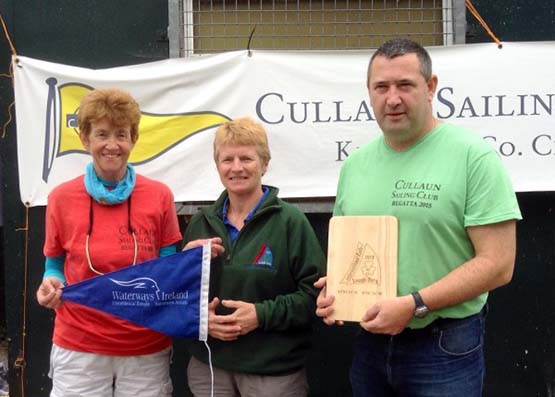
Cullaun SC Sailing Secretary Margaret Hynes, Monica Schaeffer of the Wayfarer International Association, and Jim O’Sullivan, Commodore Cullaun SC, at the presentations after the regatta. Photo: Roger Duff
With a core group of 70 sailors participating throughout the week, and 83 attending in all from 11 countries as far and wide as South Africa, Canada, USA, Latvia, Finland, Denmark, Holland and all the home countries, it might have seemed a monumental effort for everyone to up-sticks on the Sunday and road trail through East Clare and West Tipperary.
But compared to some of the distances cruising Wayfarers are prepared to travel, it was a doddle. And all this was comfortably achieved by a diverse group whose ages ranged from senior sailors Dick Harrington and Jane Karver from Michigan in the US – both are in their eighties – to most junior participant Lara Killen (9) from East Down YC in Strangford Lough.
With their centre of operations now re-established at historic Lough Derg YC (founded 1835) in Dromineer, they had the perfect inland sea of Lough Derg as the setting for their International Rally, in which racing takes a back seat so far back it’s virtually invisible. The purpose is sailing friendship, exploring new areas, finding strange ports, and enjoying the company of fellow enthusiasts with each day providing an entertaining lunchtime stopover, then each evening providing a different programme of hospitality back at Dromineer.

Centre of operations. Lough Derg Yacht Club at Dromineer was the host club and setting for several parties and feasts during the week.
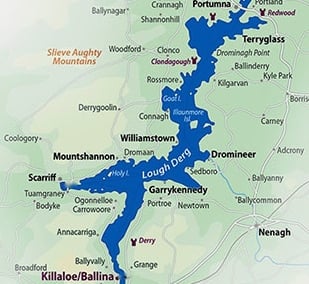
Lough Derg is 40 kilometres from Portumna down to Killaloe, and 16 kilometres from the most distant part of Tipperary to the east across to the most westerly part in County Clare. The Wayfarers got south to Killaloe, west to Scariff, and north to Terrglass, as well as many places, ports and islands in between.
 A welcome for Wayfarers - Garrykennedy was the first port of call during the cruising part of the Wayfarer International rally 2015
A welcome for Wayfarers - Garrykennedy was the first port of call during the cruising part of the Wayfarer International rally 2015
Thirty-seven Wayfarers were on the water, with all marques represented from 55-year-old woodies to brand new GRP MK IV Hartley versions. The versatility of the Wayfarer really came into its own, for here indeed was a family fun boat that can be easily reefed, rowed, paddled or motor sailed. Most of the cruising boats at the rally had at least roller furling foresails with slab reefed mains and carried three or four on board, with a maximum capacity of six.
The Sunday night saw the Lough Derg part of the programme get under way at Dromineer with supper in the club house. Monday dawned bright with a nice Force 3 to get everybody comfortably down to Garykennedy in time for lunch in Larkins pub and home again in time for a lively party with fantastic trad session in the club. The week’s programme continued with a cruise to to Scariff where the fleet enjoyed winding their way up the narrow river between the reeds again in glorious sunshine with a gently following breeze that allowed some to drop the main and furl the jib and continue on up the river under spinnaker alone – magic.
An international pot luck supper provided by the Irish and Brits fed the hungry fleet and the night was danced away to the sounds of the O’Connors on the chords until the wee hours. Next day’s cruising saw the fleet heading to Mountshannon and savouring the delights of local hospitality while spending some time watching the sea eagles nesting there.
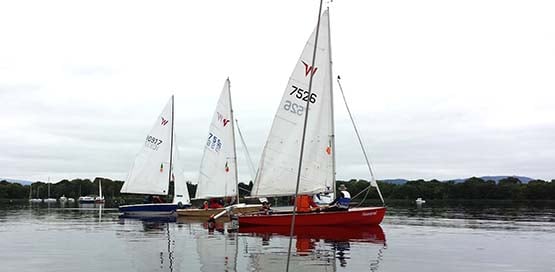 Waiting for a breeze in Dromineer Bay and properly displaying their Irish courtesy ensigns are visiting English boats (left to right) Ringle (Mike Higgins & John Kelly), Dylan (Sue & Allen Parry) and the wooden-built Samurai (Bob Tarn) with the Torqueedo outboard which gives a Wayfarer very impressive speed. Photo: Monica Schaeffer
Waiting for a breeze in Dromineer Bay and properly displaying their Irish courtesy ensigns are visiting English boats (left to right) Ringle (Mike Higgins & John Kelly), Dylan (Sue & Allen Parry) and the wooden-built Samurai (Bob Tarn) with the Torqueedo outboard which gives a Wayfarer very impressive speed. Photo: Monica Schaeffer

Second-oldest boat taking part was the immaculately-maintained 55-years-plus Sink the Pink (Rodney Hall & Gordon Reid) which is sail number 404 in a class which has now listed more than ten thousand boats. Photo: Roger Duff
The powers of observation among the Wayfarer fleet were tested more thoroughly on another occasion in mid-lake, when Miriam McCarthy of Greystones SC, crewing for Monica Schaeffer on Anamcara, spotted a Belgian angler in serious difficulties. He’d tried to start his outboard when it was in gear, and had been thrown over the side of his boat when the engine burst into life. He was careering round in circles clinging onto the gunwhale. with the engine still going full blast putting him at every risk of being severely injured by the propeller should he lose his grip. But fortunately the Greystones crew were able to contact their fleet’s own accompanying safety boat (skippered by Mike Fisher, also of Greystones), and what could have been a tragic accident was quickly averted. It was certainly much appreciated by Johnny the Belgian, who turned up next day in Dromineer fully recovered, and in search of those who rescued him to give his heartfelt thanks.

There were a couple of breezy days, and though it was very sheltered in the LDYC berths, Way Fair Lady (East Down YC) and Anamcara (Greystones SC) have taken in two reefs in one case, and one in the other. Roller furling jibs are virtually standard for cruising.
Wednesday saw the gang head down to Killaloe in a fresh breeze that took them on a speedy port reach practically the whole way. A pleasant wander around the old towns of Killaloe, and Ballina on the east shore with a hearty seafood chowder lunch on the riverside lawn of Flannigans, was followed by another cracking run all the way back to Dromineer. Back at LDYC a BBQ was in full swing and singing and dancing was the order of the night. Thursday was, a soft day with the rain teeming down but a nice breeze that tempted just seven boats each with three or four crew to venture out north towards Terryglass for a fast and exhilarating run that many said was one of the best sails they had ever experienced.
Some of those who didn’t fancy a sail in the rain took the opportunity to explore the wonders of the Wild Atlantic Way – optional non-sailing days are expected in the Wayfarer International Rally programme - while others visited more local attractions and walking trails. After the damp day or two, Friday saw the sun peeping out again and the fleet reconvened for some more idyllic cruising to the Holy Island of Iniscealtra and around the lake before a fun-filled evening in the Whiskey Still in Dromineer, complete with local artistes playing a few tunes and everyone joining in with the craic.
 The lake sailors’ pub – the Wayfarers put quite a bit of business through the famous Whiskey Still in Dromineer
The lake sailors’ pub – the Wayfarers put quite a bit of business through the famous Whiskey Still in Dromineer
Lough Derg YC were hosting the Fireballs and the 420s for some more serious racing on Saturday September 12th, but the Wayfarers opted to do something a little different, and so had an adventure race around the lake that required ingenuity and navigation skills as well as general seamanship to get your boat around the course as quickly as possible whilst also completing tasks in various stops along the way such as measuring the depth and counting the berths in Dromaan, stopping in Garrykennedy for lunch, searching for buckets in wells, and counting the “swingers” on the quay wall.... after another hearty lunch the fleet gathered for the second leg and under the starters orders were off for a thrilling reach up the lough around the islands and back to LDYC where the finish was only complete after a double loop sailed around Goose Island and through the gate to the finish.
The winners of this final marathon, the nearest thing to an orthodox race in the Lough Derg part of the rally programme, were Kit Wallace of Canada and Jonathan Dart from England sailing Ramor 1, one of the boats provided by the rapidly expanding Lough Ramor Watersports Club at Virginia in County Cavan, where the Wayfarers will be gathering again in the first weekend of October. Second were Mike Higgins and John Kelly in Ringle from England, while Ireland took third with Monica Schaeffer of Greystones, crewed by Miriam McCarthy and Christine Heath.
The rally grand finale dinner was held in the Thatched Cottage pub/restaurant just up the road from Dromineer in Ballycommon, where the gang were very well looked after by Noreen and her wonderful crew who provided a delicious meal while the Wayfarer Stompers led by Poul Ammentorp from Denmark provided the music, with the gang joining in for a fun-filled and rousing sing along.
On Sunday September 13th the weather closed in again (don’t we all know it), with only a few hardy souls heading out in half a dozen boats while the rest of the gang began packing up their boats, expressing their warmest thanks to Lough Derg YC for the fabulous hospitality, and preparing to make the long treks home filled with great memories of an excellent rally and loads of new friends made at the Wayfarer International Rally 2015.
Next year, the class are off to The Netherlands, where the Rally will be combined with the International Championships, aka the Wayfarer Worlds. For that, the numbers are already building with 30+ boats already entered. More info at www.wayfarer.org.uk or from Monica Schaefer at [email protected]. And for anyone who is interested, Hartley Boats provided a couple of brand new Mark IV Wayfarers for charter by overseas visitors at the Lough Derg Rally, they are still in Ireland and might still be available for sale at “demo boat prices” .

Memories of late summer lake sailing. Terry Cook from England sailing Herbie in perfect conditions on Lough Derg. Herbie also took the prize for top visiting boat at Cullaun.
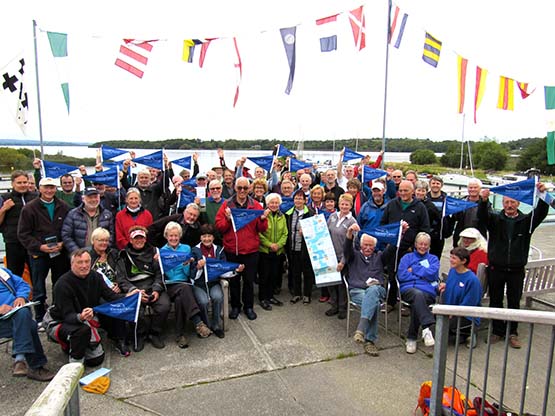
The final roundup – happy Wayfarer Ralliers 2015 gather at Lough Derg YC at Dromineer. Photo: Pimo Saarenen (Finland).
Dublin Bay Mermaid 'Voyage Home' Arrives in Crookhaven
#mermaid – When the ubiquitous DBSC Mermaid was established in the 1930's, few could have envisioned the class would continue to flourish 80 years later with new boats still being built and large competitive fleets regularly racing around the country.
The Mermaid is 3 person ¾ decked dinghy designed by "Skipper" John Kearney, a noted member of the National Yacht Club, during the first half of the 20th Century and well known internationally for many iconic designs. The brief given to Kearney by a group of Dun Laoghaire sailors was to design and build a rugged, but lively centre board dinghy suitable for Dublin Bay for no more than the cost of a motor cycle. It is a robust seaworthy boat with a good turn of speed and is very demanding to get best out of it when racing.
Over the years almost 200 boats have been built and with about 60 boats still active, it remains one of the largest racing fleets in the country. Whilst retaining its classic construction, the boat has carefully evolved over the years and become faster, easier to sail and most importantly, stronger and much easier to maintain.
The Mermaid Class is celebrating its 80th Anniversary in 2012 with up to 50 boats expected to attend the National Championships in Skerries in August.
As part of the celebrations, the Class decided to undertake an East about cruise in relays from Foynes on the Shannon, a leading Mermaid stronghold, to the spiritual home of the Mermaid in Skerries. The trip, known as "The Voyage Home", organised by Therese Mc Hugh a former MSA President, plans to visit most of the wonderful cruising locations on the South Coast culminating with hopefully what will be some fast sprints up the East Coast to arrive in Skerries on the weekend before the Championships. It is hoped that as many as 30 boats will participate in the last legs from Dun Laoghaire to Skerries via Rush. All the locations where Mermaids are regularly sailed will be visited during the trip including Dungarvan, the most recent area where Mermaids have established a foothold under the leadership of Eugene Burke.

Thumbalina passes the Mizen on her journey home
Following spectacular sailing over the last two weeks the boat being used for the trip, Thumbalina No 26 (built in 1953 and currently owned by Patrick Boardman), has arrived in Crookhaven. Highlights so far include visits to Smerwick Harbour, Derrynane and fabulous passages through Dursey Sound and the Blasket Sound. Encounters with Dolphins and ideal benign sailing conditions have been features of the first 3 legs. By the completion of the "Voyage Home", it is hoped that virtually all the active sailors in the fleet will have participated in at least one leg.
The vibrancy of the Class is manifested with the imminent launching of 3 new boats built in Rush over the last 9 months. This project has been managed by Enda Weldon who is putting together his second boat since the mid 90's.
Over the next week Thumbalina will be sailed to Baltimore and then to Glandore with a planned arrival in Kinsale by 23rd June.
Is 'Adventure Sailing' a New Tack for Dinghy Sailors?
#DINGHY SAILING – It is a common complaint that dinghy sailing is in decline. Veteran keel-boat sailors wax nostalgic about those long-gone days when huge fleets turned out for the major dinghy class championships writes our correspondent Magheramore.
Yet there were 292 entries for the recent Mitsubishi Youth National Championships, the winter Laser racing in Howth is flourishing as are the DMYC Frostbites.
However, a closer look at the dinghy park at the Youth Nationals did indicate where a problem may lie. All the boats were recent, the sails were new, many competitors were professionally coached or accompanied by their parents in a comfortable RIB. One would expect this, the young sailors (and their parents) want to do well. The impression given is that dinghy sailing is an expensive pastime requiring dedication, athletic prowess and intensive training. This perception may erect a psychological barrier to entry to the sport. Apprentice sailors, young in years or young of heart, may decide that other forms of messing about in boats are more accessible: crewing on big boats, angling, kayaking or rowing.
Racing is only one aspect of dinghy sailing. If racing is compared to track athletics, how about a nautical stroll in the park or some nautical hill walking! Dinghy cruising has been defined as sailing a dinghy for any other reason than racing. That may be too sweeping a generalisation. Perhaps a better way of putting it would be that dinghy cruising is all about going somewhere in a small boat.
There is an extreme branch of the sport: the late Frank Dye's Wayfarer crossings to Norway and to Iceland; Webb Chiles circumnavigation in a Drascombe Lugger or the two Royal Marine officer's expedition through the North West Passage 17.5ft Norseboat. Oceanic openboat sailing has it's founding fathers: Shackleton and Crean, Captain Bligh and our own St. Brendan.
But just as not all hill walkers attempt to scale Everest, or even Carrantuohill, there are many who enjoy a more gentle sail. I have often admired a venerable Mirror, usually sailing without a jib, cruising round Dun Laoghaire harbour. If you look carefully there are Wayfarers, Drascombes and others tucked away at the top of many a sheltered beach or creek, waiting a family picnic, an evening sail or a trip out to catch a mackerel or two for breakfast. In parts of Donegal, and possibly elsewhere, the humble Mirror seems to have replaced the more traditional curragh. Used as a tender, a fishing boat, a swimming platform or for short sail the Mirror can be bought cheaply, launched and recovered single-handed and can be sailed (with one or two sails), rowed, paddled, sculled or even (shudder) motored.

A UK dinghy visitor Jady Lane moored in Athlone. Photo: Aidan de la Mare
Successful dinghy cruising does not depend on a new boat. Indeed one might be happier when beaching on a stony beach if the gel coat already has a scratch or two. Boats for such sailing are a personal and often somewhat idiosyncratic choice. Who would have thought that a Finn could be converted into practical cruising yawl? Or that a Mirror dinghy could cruise from the Severn to the Black Sea, with the skipper sleeping "comfortably" aboard. Stability is the one essential design feature, indeed some dinghy cruisers maintain that the Wayfarer is far too tippy a boat.
Many dinghy cruising sailors never progress beyond pottering or day sailing. A lifetime is too short to explore the nooks and crannies of the Irish coast line, not too mention the many loughs. When camping or self-catering beside the water, having a dinghy ready to launch greatly enriches the holiday. Yet, inevitably, there comes a day when the the skipper wants to sail out to that distant island, or around the point, too far to return the same day. At this point the huge advantage of exploring in a dinghy rather than on foot becomes obvious. Even in the smallest dinghy room can be found for a tent, foam mattress, sleeping bag, stove, provisions and, luxury, a bottle of wine and a corkscrew! The boat does the carrying rather than your back. There are many places round the coast where a tent can be pitched discreetly. The sea-kayaking fraternity have been doing this for years.
Most cruising sailors then realise that it is in fact more convenient to sleep on board. This is no less comfortable than sleeping in the kind of bivouac tents used by back-packers and cyclists. There is also one great advantage, by choosing an appropriate anchorage one can escape the midges!
Dinghy cruising is not a structured activity. Most cruising sailors are fiercely independent, and most stay well away from yacht clubs. Yet the Dinghy Cruising Association in the UK has 468 paying members (some of them in Ireland), with a further 29 joining in the last 3 months. Races are not part of their programme. Rallies can be low key – meet for lunch, or an overnight stay at specified spot (often conveniently situated within strolling distance of a welcoming pub). There is a developing trend to organise Raids – cruises in company, sometimes with an element of competition. An annual Raid is organised through the Great Glen in Scotland. Others are held in the Baltic. Above all, the traditional boat revival in France has been accompanied by explosion in events for "voile-aviron" (sail and oar). Especially if you have a wooden boat, you will be welcome at the big traditional boat festivals such as those held in Brest and Douarnenez. Perhaps one day there will be a Raid Ireland?
In short, pottering or cruising in small open boats is an exciting adventure open to all. The seamanship skills learnt taking a boat from Bray up to Dalkey Island, or from Dromineer to Mountshannon can be of much use to a budding sailor as learning to roll tack a Laser. In fact, dinghy cruising, probably renamed "adventure sailing", opens a whole new world for sailing schools and club training. Transition year groups or the local Scout troop would certainly be interested. As more extreme outdoor pursuits, from fell-running to bog-snorkelling, gain new participants, there is surely room for dinghy cruising – Magheramore
Wtih thanks to the Dinghy Cruising Association for photography in this article


























